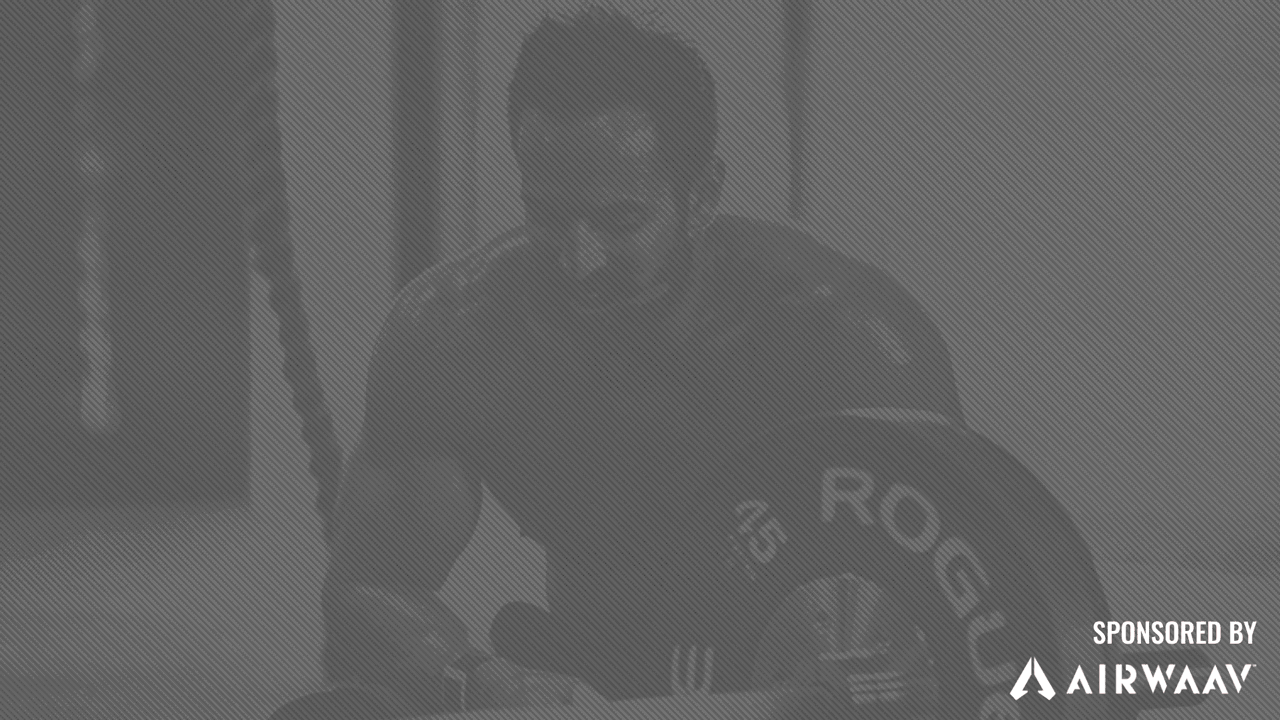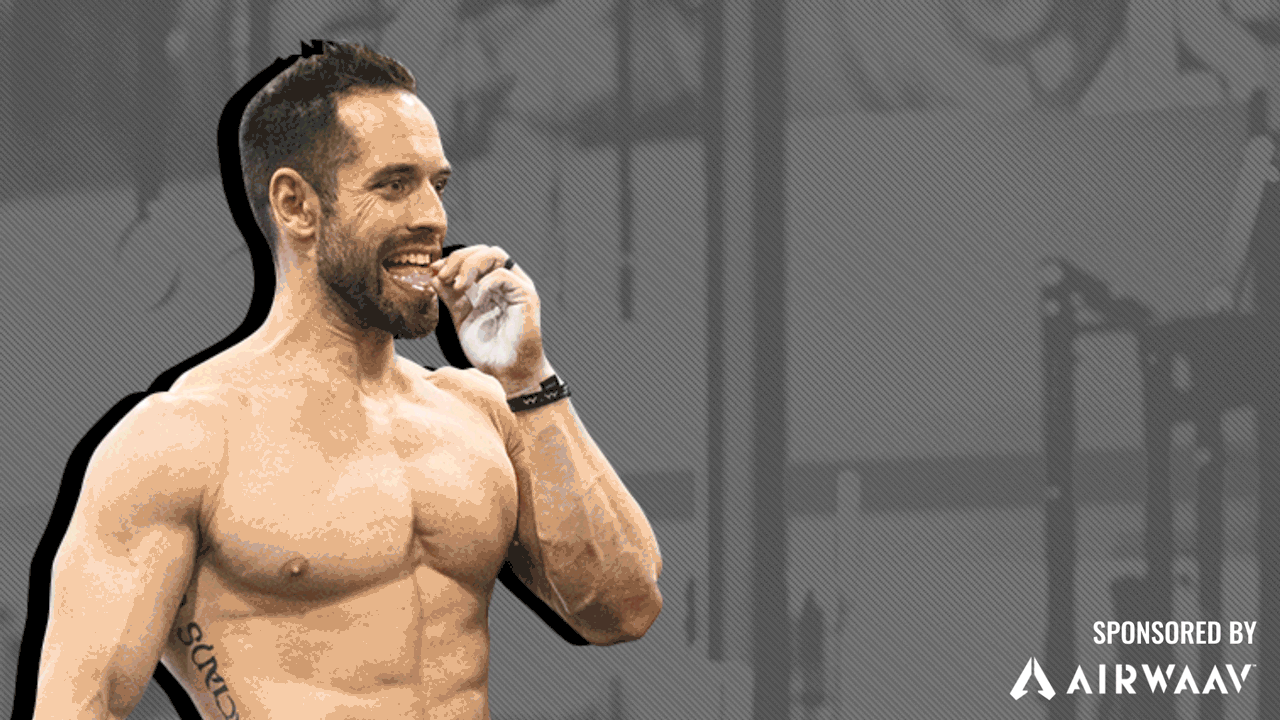To compete at the highest levels of CrossFit competition, many might think that strength, speed, agility, endurance, stamina, conditioning, form, or a plethora of other physical aspects are most important to elite performance. But ask four-time Fittest Man on Earth®, Rich Froning, and you might get an answer often overlooked: breathing.
Proper breathing technique, using equipment that supports that technique, and training that technique as one might do for a major muscle group during competition prep are key aspects to Froning’s ongoing dominance at the CrossFit Games. In addition to his four individual Games titles (2011-14), he has four team titles with Team CrossFit Mayhem (2015-16, 2018-19) and is returning to the NOBULL CrossFit Games in 2021 in search of a fifth. Froning’s choice to improve his breathing: The AIRWAAV™ Performance Mouthpiece.

The Official Mouthpiece of the 2023 World Strongest Man, this performance mouthpiece is custom-built to fit an athlete's mouth and enables better breathing via controlled tongue placement. It is ideal for competitive athletes looking to improve their performance and speed up their recovery.
Editor’s note: The content on BarBend is meant to be informative in nature, but it shouldn’t take the place of advice and/or supervision from a medical professional. The opinions and articles on this site are not intended for diagnosis, prevention, and/or treatment of health problems. Speak with your physician if you have any concerns.
[Related: The Ultimate Workout Split to Build Strength and Muscle Mass]
According to AIRWAAV™, their Performance Mouthpiece is backed by a decade and a half of research and development with elite athletes like Froning to “perfect the most efficient way of opening the airway and optimizing performance.” That optimization can set athletes apart from their competition.
A 2013 review of respiratory muscle training in the Journal of Strength and Conditioning Research compiled the results of 21 studies that determined “a significant positive effect of respiratory muscle training (RMT) on sport performance outcomes of time trials [and] exercise endurance time.” (1) In Laymen’s terms, functional fitness athletes who train their breathing won’t fatigue as quickly and will, therefore, improve WOD times.
Rich Froning Trains Breathing
Froning recognized the importance of breathing in the midst of the Triple-3 event at the 2014 CrossFit Games. He was the three-time defending champion entering that contest and left it as the first-ever four-time champion. However, during the Triple-3 event, which consisted of rowing 3,000 meters, performing 300 double-unders, and running three miles for time, Froning finished in 37th position with a time of 38:31.38 — 5:27.82 behind the winner of the event, Rob Forte. It was the worst finish for Froning across any of the 13 events at that year’s Games.
Over the past five years, Froning has “put a considerable amount of attention into [his] breathing when training” with the guidance of endurance coach Chris Hinshaw.
View this post on Instagram
Froning starts each training day with a cold shower, which has been shown to reduce non-comorbidity illness by 29 percent. (2) It can also put Froning in a better mindset to train. Exposing skin, which has a high density of cold receptors, to water at a temperature of 68 degrees Fahrenheit for two to three minutes, activates the sympathetic nervous system and results in an anti-depressive effect. (3)
In addition to starting each day with a cold shower, Froning will perform a “cold plunge” three to five times per week after workouts. Those cold showers and cold water immersion post-workout might help him improve his ability to maintain control of his breathing during intense activities. The respiratory response to skin cooling overrides “both conscious and other autonomic respiratory controls and may act as a precursor to drowning.” (4) Although his body can’t discern that it is not in any danger, Froning can focus on controlling his breathing as his body adjusts to the colder temperature. The benefits are reduced delayed onset muscle soreness. (5)
According to Froning, that improvement in recovery is vital to competition performance:
“Recovery is king in a sport that’s based around a clock,” he says. “When it matters most, if your heart rate and breathing are out of control, everything else falls apart.”
AIRWAAV’s Training Benefits
So, where does AIRWAAV™ fit into Froning’s training?
It makes sense that Froning “felt the most benefit in breathing during heart-rate-focused workouts like metabolic conditioning, mountain biking, or flag football” after a few weeks of getting acclimated to using the AIRWAAV™ Performance Mouthpiece — the first breathing aid he’s ever incorporated into his training.
Wearing it during lifting sessions required no adjustment.
According to AIRWAAV™, “computed tomography (CT) scans prove [their] mouthpiece increases the width of your airway an average of nine percent.” The science backs that up.

A randomized control trial in the Compendium of Continuing Education in Dentistry showed a “significant difference” in mean width…of the cross-sectional area of the oropharynx…with the mouthpiece [than] without one — 28.27 millimeters versus 25.93 millimeters (a 2.34-millimeter difference). That has a meaningful impact on lactate levels in muscles — 1.86 millimoles per liter (mmol/L) with a mouthpiece versus 2.72 mmol/L without one — after 30 minutes of endurance-based activities. (6) “Lactate is a crucial intermediate in carbohydrate and nonessential amino acid metabolism” — meaning that it allows glucose breakdown to continue in muscles (read: produce energy) when oxygen is not readily available due to intense exercise. (7)
In addition to increased airway space and lower lactate levels during exercise, the use of AIRWAAV™’s Performance Mouthpiece can significantly lower respiratory rate. Wearing a mouthpiece while running requires athletes to take three fewer breaths per minute on average versus foregoing a mouthpiece altogether to achieve the same steady pace. (8)
With a lower respiratory rate comes increased endurance and lower levels of the stress hormone cortisol that the body releases during exercise. The use of a mouthpiece noticeably decreases the build-up of cortisol in athletes post-training compared to athletes who don’t use a mouthpiece. (9)
Tongue Position
The AIRWAAV™ Performance Mouthpiece is designed to “train and position your tongue” in what would be considered the “UP” position in a study in the Muscles, Ligaments, and Tendons Journal. The UP position with the AIRWAAV™ Performance Mouthpiece is where the tip of the tongue sits under the Intake Bar positioned behind the lower teeth. This allows the tongue to flex to the “palatine spot,” which better opens the airway and can increase the performance of “knee flexion peak torque” by upwards of 30 percent. (10)
Tongue position having such a large impact on knee flexion is a clear example of how training breathing can significantly affect other areas of fitness that are not obvious in a positive manner. Even the study’s title noted it as “highly surprising.”
[Related: Is Lifting Weights Hurting Your Teeth?]
Custom Fit
AIRWAAV™ Performance Mouthpiece can be custom fit to an individual’s mouth using a microwave, paper towels, cold water, and a slotted spoon. The video above demonstrates how to use the cold water and paper towels with the mouthpiece before microwaving it to be molded to the athlete’s mouth.
Mouthpieces that are not custom fit can protect teeth but can also increase the number and intensity of oral mucosal injuries. Such injuries can cause further negative soft tissue reactions such as hyperkeratosis, erythema, and ulceration. (11) Although the use of any mouthguard can “dampen…generated stress,” custom-fit mouthpieces proved to be “more beneficial for preventing trauma during at-risk activities of impact.” (12)
Breathing Awareness
According to Froning, AIRWAAV™ is influencing his training “by bringing awareness to [his] breathing so [he’s] more equipped to handle the curveballs that are sure to come at [the 2021] CrossFit Games.” That breathing awareness is not only beneficial for the competition’s potential “curveballs” but can also provide beneficial effects on blood pressure. (13)

Individuals who are more acutely aware of their breathing incur fewer “breathing irregularities,” such as sighs and end-expiratory pauses. (14) More consistent, slower breathing “enhances autonomic, cerebral, and psychological flexibility” (15) — which can be valuable when handling a variety of unexpected implements while under pressure competing against the world’s best functional fitness athletes.
AIRWAAV Performance Mouthpiece
The AIRWAAV™ Performance Mouthpiece is available for purchase on airwaav.com. Each mouthpiece comes with its own protective carrying case.

The Official Mouthpiece of the 2023 World Strongest Man, this performance mouthpiece is custom-built to fit an athlete's mouth and enables better breathing via controlled tongue placement. It is ideal for competitive athletes looking to improve their performance and speed up their recovery.
References
- Bahareh HajGhanbari, et al. Effects of respiratory muscle training on performance in athletes: a systematic review with meta-analyses. 2013. Journal of Strength and Conditioning Research. doi: 10.1519/JSC.0b013e318269f73f
- Geert A. Buijze, et al. The Effect of Cold Showering on Health and Work: A Randomized Controlled Trial. 2016. PLoS One. doi: 10.1371/journal.pone.0161749
- Nikolai A Shevchuk. Adapted cold shower as a potential treatment for depression. 2008. Medical Hypotheses. doi: 10.1016/j.mehy.2007.04.052
- Avijit Datta, Michael Tipton. Respiratory responses to cold water immersion: neural pathways, interactions, and clinical consequences awake and asleep. 2006. Journal of Applied Physiology. doi: 10.1152/japplphysiol.01201.2005
- Angus Lindsay, et al. The physiological response to cold-water immersion following a mixed martial arts training session. 2017. Applied Physiology, Nutrition, and Metabolism. doi: 10.1139/apnm-2016-0582
- Dena P Garner, Erica McDivitt. Effects of mouthpiece use on airway openings and lactate levels in healthy college males. 2009. Compendium of Continuing Education in Dentistry. Jul-Aug 2009;30 Spec No 2:9-13
- Jansen Seheult, et al. Lactic acidosis: an update. 2017. Clinical Chemistry and Laboratory Medicine. doi: 10.1515/cclm-2016-0438
- Dena P Garner. Effects of various mouthpieces on respiratory physiology during steady-state exercise in college-aged subjects. 2015. General Dentistry. Nov-Dec 2015;63(6):30-4
- Dena P Garner, et al. The effects of mouthpiece use on cortisol levels during an intense bout of resistance exercise. 2011. Journal of Strength and Conditioning Research. doi: 10.1519/JSC.0b013e31820ae849
- Rosa di Vico, et al. The acute effect of the tongue position in the mouth on knee isokinetic test performance: a highly surprising pilot study. 2o13. Muscles, Ligaments, and Tendons Journal. Oct-Dec; 3(4): 318–323
- Richard T Glass, et al. Protective athletic mouthguards: do they cause harm? 2009. Sports Health. doi: 10.1177/1941738109341441
- João Paulo Mendes Tribst, et al. Influence of custom-made and stock mouthguard thickness on biomechanical response to a simulated impact. 2018. Dental Traumatology. doi: 10.1111/edt.12432
- Vernon A Barnes, et al. Impact of Breathing Awareness Meditation on Ambulatory Blood Pressure and Sodium Handling in Prehypertensive African American Adolescents. 2011. Ethnicity and Disease. Ethn Dis. 2008 Winter; 18(1): 1–5
- J N Han, et al. Influence of awareness of the recording of breathing on respiratory pattern in healthy humans. 1997. The European Respiratory Journal. doi: 10.1183/09031936.97.10010161
- Andrea Zaccaro, et al. How Breath-Control Can Change Your Life: A Systematic Review on Psycho-Physiological Correlates of Slow Breathing. 2018. Frontiers In Human Neuroscience. doi: 10.3389/fnhum.2018.00353
Featured Image Courtesy of AIRWAAV